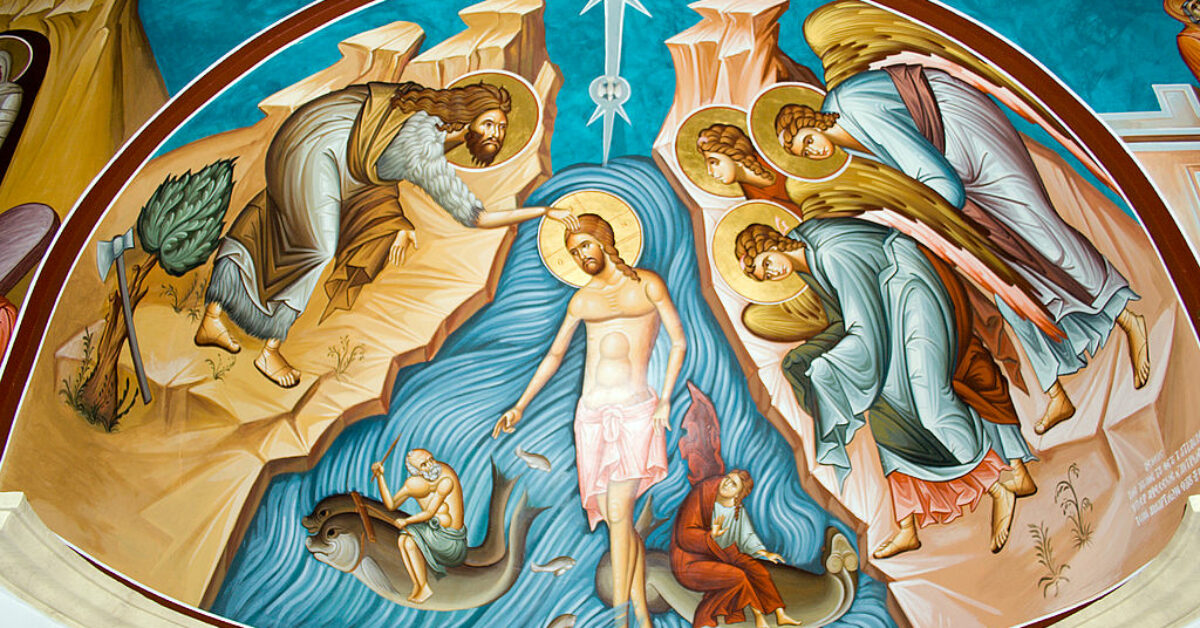Awe-Inspiring: Sharing in Jesus’ Jordan Experience
The images are many but the reality is one. Three weeks ago in this series on the ancient mystagogy, Rhoda led us into the multivalence of the baptismal images. Baptism is both tomb and womb in the mystagogy of Ambrose and Theodore. It also adoption and cleansing and the pouring out of the Spirit (more on that in two weeks in relationship to post-baptismal anointing). A book that brings together all of the images on baptism that I would highly recommend is Maxwell Johnson’s Images of Baptism (originally published by LTP, now available independently on Amazon). But, is there a unifying reality among the images of baptism, something that expresses that baptism is one? I would contend that there is and it is something in Lutheran reflection that doesn’t have a primary place, but that does for the church fathers: The Baptism of Jesus in the Jordan.
As Yarnold (The Awe-Inspiring Rites of Initiation, 27) notes, all four mystagogues “refer to Christ’s baptism … in explaining the symbolism of baptism and the way in which it confers grace.” Although, all four explore the import of Jesus’ baptism in different ways. Chrysostom (the text of which is not in Yarnold) “takes it to be a paradigm of Christian baptism: Just as Jesus was baptized by the Word (which led his body down into the Jordan), by the Father (who spoke from heaven), and by the Holy Spirit (who descended), so too we are baptized by the Trinity” (27). Chrysostom grounds the Trinitarian baptism of the Christian in the Trinity’s manifestation at Jesus’ baptism and thus in the life of the Trinity.
Both Cyril of Jerusalem and Ambrose highlight that “Christ’s entry into the Jordan gave the baptismal water its sanctifying power” (27). This understanding of the significance of Jesus’ baptism will be captured in the various water consecration prayers in the early and medieval church’s baptismal liturgy (Luther’s Flood Prayer is a translation of and develops out of one of these water consecration prayers). Cyril refers to Christ’s descent into the Jordan and the Holy Spirit’s anointing upon Jesus as the basis for the descent, emergence and anointing of the Christian in the pool of baptismal water. He says of Jesus’ action, “Christ bathed in the river Jordan, and having invested the water with the divine presence of his body, he emerged from them, and the Holy Spirit visited him in substantial form, like coming to rest on like” (81-82). Ambrose is even more explicit about the sanctifying power of Jesus and the Spirit when referring to the water consecration prayer in use in Milan [parentheses mine]:
You saw the water, but not all waters have a curative power: only that water has it which has the grace of Christ. There is a difference between the matter and the consecration, between the action and its effect. The action belongs to the water, its effect to the Holy Spirit. The water does not heal unless the Spirit descends and consecrates the water….Christ came down, the Holy Spirit came down. Why did Christ come down first, and the Holy Spirit afterwards, since the normal rite of baptism follows this order: first the water is consecrated [assumed action of the Spirit] and then the candidate for baptism comes into it [Christ’s descent]? For, when the bishops enters [the baptistery], he first performs the exorcism on the creature which is the water, and then utters invocation and prayer that the water may be sanctified and the eternal Trinity may dwell there. But Christ descended first, and the Spirit came after. Why was this [since the liturgical practice seems the opposite]? It was in order that the Lord Jesus might not appear to have need of this mystery of sanctification, but that he himself might sanctify, and that the Spirit might also sanctify (105-107).
Christ has no need of sanctified water, but we DO!
Theodore of Mopsuestia is the most explicit about the connection between Jesus’ baptism and our own:
Our Lord, then, was baptized by John, but not with John’s baptism….He was baptized with our baptism, and presented an anticipation of it….You were baptized with the same baptism that Christ our Lord received in his humanity. This is one reason you are baptized ‘in the name of the Father and of the Son and of the Holy Spirit’, because the very events of Christ’s baptism foreshadowed your baptism in sign. When the Father said aloud from far off, ‘This is my beloved Son, with whom I am well pleased’, he was referring in fact to the grace of our adoption, which is the purpose of baptism (195-6).
The Father identifies Jesus as his beloved Son at his baptism. He does this so that same word might be spoken to and over us. By virtue of Jesus’ baptism, we in our baptisms are adopted by name by the Father as His own daughters and sons. All through the power of baptismal water sanctified by the Word in Jesus’ baptism.
